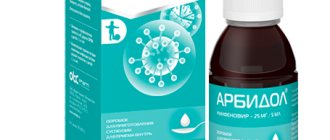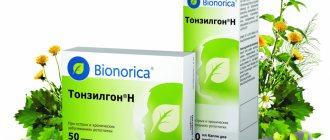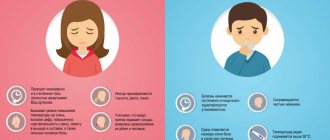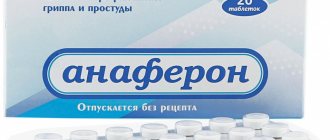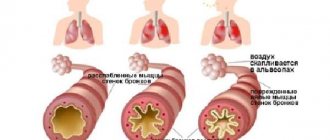Operating principle
The composition of the drug at first glance may raise questions. The instructions say: contains affinity purified antibodies to human interferon gamma. Everyone knows that interferons are the main part of our immunity, so why act against them with “anti” bodies? The idea is that ultra-low doses of antibodies lead to an enhanced immune response. Anaferon triggers a whole cascade of protective reactions, increasing the production of alpha, beta and gamma interferon, killer cells, phagocytes and many others. As a result, a person fights influenza viruses, ARVI, as well as herpes types 1 and 2 faster and without complications.
The main feature of antibody-based drugs is their safety, and therefore Anaferon is widely used as a prophylactic for influenza and ARVI.
General indications for the use of Anaferon are as follows, complex therapy:
- Flu;
- Acute respiratory viral infection;
- Genital herpes;
- Labial herpes.
Given the mildness of the drug, doctors recommend it to people with chronic diseases. Patients who correctly followed the Anaferon dosage regimen highly appreciated its effectiveness.
The manufacturer, Materia Medica, is the leader among our companies that have funded clinical trials (2018). In addition, Anaferon is one of the most studied drugs in its sector. All these facts convince doctors to prescribe it to children starting from the age of one month.
Indications for use Anaferon for children drops
Treatment of ARVI in children from one month to three years.
How to use Anaferon for children in the form of drops?
The treatment regimen with this drug in any form differs in the frequency in the initial period and when taken separately from food. It is more convenient to record time using a clock. For children older than one month, the following dosage is indicated:
The first day of treatment - for 2 hours - 10 drops every 30 minutes, then another 3 times 10 drops at equal intervals; from 2 to 5 days of treatment - 3 times a day, 10 drops
Important! On the initial day, during five doses, drops are given between feedings or 15 minutes before food or water. This rule is also observed when treating with tablets, since food sharply reduces the bioavailability of the drug.
Material and methods
Data search and selection strategy
A search for information about CI in open sources (on the Internet, medical library) was carried out using the keywords “Anaferon” and “Anaferon for children.” The searches were not restricted by language, date, or publication status. The information search strategy included access to official websites - domestic and foreign CT registries and databases, electronic libraries, including: State Register of Medicines (grls.ru); US National Library of Medicine ClinicalTrials.gov (clintrials.gov); International Clinical Trials Registry Platform (ICTRP) WHO (www.who.int/ictrp/search/en), PubMed, EMBASE, MEDLINE, Cochrane Library, scientific electronic library eLIBRARY.RU, Russian Scientific Electronic Library CyberLeninka (cyberleninka.ru). To increase the representativeness of data on efficacy and safety (obtaining information as part of pharmacovigilance), reports on the results of clinical trials were requested from the manufacturer.
Criteria for selecting CTs for inclusion in meta-analysis:
study design: prospective RCT;
RCT participants:
male and female patients aged from 1 month. with a diagnosis of ARVI/influenza/ARI (acute respiratory infection of viral origin) for Anaferon for children according to the indication “treatment of ARVI/influenza”;
male and female patients aged from 1 month. for Anaferon for children and from 18 years of age for Anaferon for the indication “prevention of ARVI/flu”;
the use of the drugs Anaferon and Anaferon for children in RCTs for the prevention and/or treatment of ARVI/influenza according to the instructions for their medical use [3–5];
using the duration of the disease and/or the duration of the febrile period as one of the end points/efficacy criteria in RCTs studying the therapeutic effectiveness of Anaferon for children in ARVI/influenza;
use as one of the end points in an RCT to study the preventive effectiveness of Anaferon and Anaferon for children against ARVI/influenza of the proportion of non-sick/sick patients.
RCTs that did not meet the inclusion criteria, duplicate publications of RCT results, and studies with insufficient data for statistical analysis were not included in the meta-analysis. A risk of bias analysis was performed to assess the methodological quality of the RCTs. In accordance with Cochrane guidelines, the following criteria were considered: method of randomization, presence and type of blinding of the study, compliance of results with endpoints/efficacy criteria and completeness of reporting of results, followed by assessment of the risk of bias in the study as a whole as low, moderate, high and uncertain [ 26, 27].
This review includes:
meta-analysis of the therapeutic effectiveness of Anaferon for children in acute respiratory viral infections/influenza/ARI based on the end points “duration of the disease” and “duration of fever”. Additionally, the effect of the drug on the duration of intoxication, catarrhal symptoms (rhinitis and cough) and the dynamics of the level of IFN-γ and IFN-α was assessed;
meta-analysis of the preventive effectiveness of Anaferon and Anaferon for children against ARVI/influenza based on the end point “proportion of disease-free patients” with calculation of the effectiveness coefficient (EC) of the drug.
The safety of therapy was assessed taking into account the number and nature of adverse events (AEs), their relationship with taking the drug, and deviations in laboratory and vital signs while taking the drugs.
The review used modified/adapted elements from the PRISMA 2021 Checklist and PRISMA 2021 flow diagram for new systematic reviews, including searches of databases, registries and other sources [2, 25].
Statistical methodology
Descriptive statistics methods were used for preliminary statistical processing of data. Comparisons of continuous measures (duration of symptoms) between individual studies were made using Student's t test. When performing a meta-analysis of continuous indicators using pooled estimates of means and standard deviations, a Z-test was used to calculate the weighted average effect size of Hedges' g, construct a 95% confidence interval (CI) for it, and calculate a p-value to accept/reject the hypothesis that the effect was equal to zero . The 95% CI was calculated using two approaches: without taking into account the heterogeneity of results (fixed effects model, FEM) and taking this into account (random effects model, RFE). Cochran's Q statistics were also calculated, which allows us to evaluate the degree of homogeneity of study results using statistical hypothesis testing. Fisher's exact test was used to assess differences in frequencies between individual studies; to evaluate cumulative frequency data, use the Cochran-Mantel-Haenszel (CMH) test.
When analyzing preventive effectiveness, relative risk (RR) and odds ratio (OR) indicators were calculated to compare the proportion of disease-free patients. The results are presented in the form of individual and pooled indicators (OR and RR), as well as the corresponding 95% CI (drug/placebo or drug/comparison group). Data homogeneity was assessed when calculating frequency indicators using the Breslow-Day Test.
FE (%) was also calculated using the formula:
KE=100 × (b - a) / b,
where a is the incidence among individuals who received the drug, b is the incidence among individuals who did not receive the drug.
Indications of the drug and dosage for Anaferon tablets for children
- Influenza and ARVI, prevention and treatment, age 1 month - 18 years
- Complex therapy of infectious mononucleosis and chickenpox, from 1 year to 18 years
- complex therapy of rotavirus infections, 6 months - 18 years
Dosage for tablets
Interestingly, tablets, as well as drops, can be used from 1 month to 3 years, dissolving them in chilled boiled water (1 tablespoon). From the age of three you can use the tablets if you keep them in your mouth until completely dissolved. The regimen is almost the same, the difference is the duration of treatment.
For acute respiratory viral infections and influenza in children over 1 month of age:
- 1 day of treatment - give 8 tablets, the first 2 hours every 30 minutes (total 5 tablets in two hours). In the future - 3 tablets at equal intervals.
- 2nd day of treatment and then 1 tablet 3 times a day until recovery.
If you do not feel better after three days, you should seek help from a doctor.
Intestinal rotavirus infection , as part of complex therapy for children over 6 months:
The scheme is the same as for ARVI.
Infections caused by the herpes virus (chickenpox, mononucleosis), complex therapy.
The tactics are similar to those for ARVI, but only for chickenpox - continue treatment for 7 days, and for infectious mononucleosis - 14 days.
Indications for use of Anaferon for adults in tablets
- ARVI, influenza, prevention and treatment as part of complex therapy;
- Labial (herpes on the lips) and genital herpes, in complex therapy.
Anaferon dosage for adults
For labial herpes or “colds on the lips” , ARVI, influenza. The dosage regimen is the same as for children's tablets for ARVI. They need to be absorbed between meals.
For preventive purposes during the ARVI season, take 1 tablet per day for 1-3 months.
For genital herpes in acute form . There is a difference in the treatment of this pathology - 1-3 days, 1 tablet 8 times a day at equal intervals, and then - 1 tablet 4 times a day for 3 weeks.
Treatment of relapses of the chronic form of the herpes virus, 1 tablet per day, the duration is determined by the doctor, can reach 6 months.
It should be noted that the drug combines well with other antiviral agents.
Research results
Study selection
1297 publications were found in open sources using keywords, 2 publications in printed form, an additional 3 reports on clinical trials were provided by the sponsoring company. The meta-analysis included data from 11 RCTs (Fig. 1).
Assessing the risk of bias in studies
Data for assessing the risk of bias/bias in studies are presented in Table 1.
The randomization method was described in only 4 RCTs, allocation concealment was provided in 3 RCTs, where the randomization procedure was carried out using an automated interactive voice system, using a floating block method, randomizing patients into 2 groups. Also, in these RCTs, the quantity of study drug supplied to the study sites exceeded the number of planned participants, which further masked the allocation, since the researchers could not know in advance which of the 2 groups each individual patient would be allocated to. Nine studies were double-blinded (RCTs 1–9), 2 RCTs were open-label. All RCTs reported results according to their stated efficacy criteria. In general, the design of all studies included in the meta-analysis corresponded to the stated objectives, and the risk of bias according to the criteria considered could be assessed as low (RCTs 1, 2, 9), moderate (RCTs 5, 6) and uncertain (RCTs 3, 4, 7 , 8, 10, 11) [27]. The results of the risk of bias assessment as “uncertain” in RCTs 3, 4, 7, 8 relate mainly to the reporting of the study design: lack of detailed information on the method of randomization and allocation concealment, and in RCT 10 and RCT 11 on the method of blinding.
Brief description of studies included in the meta-analysis
The meta-analysis included data from 11 RCTs involving 3079 patients aged 1 month or older. up to 69 years of age, of which 1729 people participated in studies of the preventive effectiveness of drugs based on TO antibodies to IFN-γ and 1550 patients - the therapeutic effectiveness of these drugs. Nine RCTs were double-blind, placebo-controlled, and 2 RCTs were open-label. All studies were prospective, parallel group studies. Four studies (RCTs 1, 2, 4, 9) were multicenter, 2 of them were international: RCT 1 was conducted in 3 countries (Russian Federation (RF), Republic of Belarus and Ukraine), RCT 9 - in 2 countries (RF, Republic of Uzbekistan) (Table 2).
In RCTs 1, 3–11, the tablet form of the drugs Anaferon and Anaferon for children was used, in RCT 2, the liquid dosage form of Anaferon for children was used. The dosage regimen of the drugs in the RCT corresponded to the current instructions for their medical use: 1 tablet was recommended per dose (or 10 drops for RCT 2) [3–5]. Despite the differences in the dosage form of the drug and the target age audience, the specific mechanism of action of drugs based on TOAT to IFN-γ avoids the need to select an individual dosage regimen depending on the age and body weight of the patient. For therapeutic purposes, in RCTs 1–7, drugs were used in the first 2 hours every 30 minutes (5 doses in total), then during the first 24 hours - 3 more doses at regular intervals. From 2 days onwards until recovery (or 5–14 days depending on the severity of clinical symptoms) / up to 5 days in RCT 2 - 1 tablet or 10 drops 3 times a day. For prophylactic purposes in RCTs 5, 8–11, drugs were used 1 tablet 1 time per day for 3 months/12 weeks.
Of the 11 studies included in the meta-analysis, 2 RCTs were conducted in patients with ARI, 1 RCT - in patients with influenza, 6 RCTs assessed the effectiveness and safety of drugs based on TO antibodies to IFN-γ in relation to ARVI/influenza, and 2 studies - in ARI/ARVI with gastrointestinal syndrome (GIS), one of which included patients only with coronavirus etiology of the disease (Table 3).
In 6 RCTs involving 2143 patients, the pathogen was verified (PCR diagnostics, enzyme-linked immunosorbent assay, immunofluorescence, indirect hemagglutination test and transmission electron microscopy) [8, 10, 12, 15–17]. Among the pathogens of ARVI, influenza viruses predominated in RCTs 1 and 3, adeno-, rota-, and coronaviruses predominated in RCT 6, coronaviruses in RCT 7, rhinovirus and respiratory syncytial (RS) virus in RCTs 8 and 9. In RCT 9, episodes of coronavirus and bocavirus infections were noted only in the group of patients receiving placebo [8]. 4 studies involving 903 patients assessed the dynamics of viral load/clearance of the pathogen, 2 other RCTs were devoted to assessing the preventive effect of the drug, and this parameter was not assessed in them. In the remaining RCTs, diagnosis was made based on clinical findings.
A number of RCTs were devoted to studying the effect of drugs based on TO Abs to IFN-γ in special groups of patients. Thus, in RCT 5 and RCT 11, the preventive and therapeutic effectiveness of Anaferon and Anaferon for children, respectively, was assessed in individuals with chronic respiratory diseases. RCT 5 included patients with mild or moderate bronchial asthma (BA), and RCT 11 included patients with bronchopulmonary pathology (BA, chronic bronchitis, chronic obstructive pulmonary disease) [14, 19]. More than 45% of patients included in RCT 8, dedicated to assessing the preventive effectiveness of Anaferon for children, belonged to the group of frequently ill children (FIC) [17].
In addition to disease duration (RCTs 1–3, 5–7), duration of fever (RCTs 2–7) and proportion of disease-free patients (RCTs 5, 8–11), duration of intoxication (RCTs 3–7) was used as endpoints. the average duration of an ARVI/flu episode when it occurs against the background of prophylactic administration of the study drugs (RCTs 8, 10, 11) and a number of other parameters (Table 4).
In RCTs 8 and 10, the EC of the drug was calculated for influenza and ARVI [17, 18].
Security assessment
AEs were most often assessed as safety criteria (see Table 4). The total number of reported AEs was 114 when taking drugs based on TOAB to IFN-γ and 117 when taking placebo. In RCTs 1, 2, 8 and 9, there were no statistically significant differences between the study drug group and the placebo group in terms of AEs [8–10, 17]. In the remaining RCTs, no AEs were registered while taking Anaferon and Anaferon for children. During the generalized safety assessment, it was found that from the moment of registration of the drugs to May 2021, a total of 156 AEs and adverse reactions (ARs) were identified. Most of the pediatric AEs/AEs recorded during the use of the drugs Anaferon and Anaferon are manifestations of increased individual sensitivity, information about the possibility of which is contained in the instructions for medical use of the drugs [3–5]. The remaining AEs/AEs are isolated, belong to different classes of MedDRA (Medical Dictionary for Regulatory Activities) systems and organs, and have a low level of cause-and-effect relationship with the drug. Over the entire period of circulation of drugs on the market, no safety signals or other safety problems have been identified in connection with drugs based on TOABs to IFN-γ; the benefit/risk ratio for the drugs remains positive.
Results of a meta-analysis of RCTs of the effectiveness of Anaferon for children in the treatment of ARVI/influenza
A meta-analysis of the effectiveness of Anaferon for children for the treatment of ARVI/influenza was carried out based on data from 7 double-blind, placebo-controlled RCTs (RCTs 1–7) involving 1550 patients aged 1 month or older. Patients were included in RCTs 1, 2, 5 in the first 24 hours from the onset of the disease, in RCT 3 and RCT 4 - on days 1–2, and no data were found for RCT 6 and RCT 7. In all RCTs, Anaferon for children and placebo were used against the background of standard therapy for ARVI, which included taking antipyretic drugs.
To analyze the “disease duration” indicator, data from 1245 patients from 6 RCTs (RCTs 1–3, 5–7) were taken, and “fever duration” — data from 981 patients from 6 RCTs (RCTs 2–7). Additionally, the criteria “duration of intoxication” (RCTs 3–7), “duration of rhinitis” and “duration of cough” (RCTs 3–5, 7) were assessed.
On average, the duration of ARVI/flu when taking Anaferon for children was 1.4 times shorter than when taking placebo, and was 4.71±2.53 days versus 6.37±6.23 days (p<0.001). The average duration of fever when taking Anaferon for children was 2.19±1.21 days versus 3.22±1.81 days with placebo (p<0.001). The average duration of intoxication in all studies was 2.76±1.28 days in the Anaferon children's group versus 4.23±3.14 days in the placebo group, rhinitis - 3.87±1.44 days and 5.12±2.73 days, cough - 3.71±3.10 days and 7.02±6.33 days, respectively (p<0.001).
Despite the heterogeneity of data on the criteria under consideration when testing for homogeneity and the preference for using MFE for all criteria, except for the “duration of cough” criterion, for completeness, the results obtained using MFE are given below (Table 5).
According to the results of the meta-analysis, Anaferon for children demonstrated a significant superiority in the effect on the duration of ARVI/influenza and febrile syndrome over placebo in the form of a significant reduction in the duration of both the disease and febrile syndrome. The effect size, which reflects the comparative effect normalized by the standard error of the data, according to the disease duration criterion, was largest in RCT 7 and RCT 6, 2.63 and 1.88, respectively, and smallest in RCT 1 (Fig. 2A). Effect sizes for duration of fever were largest in RCTs 3, 6, and 7, at 1.52, 1.38, and 1.27, respectively, and smallest in RCT 2 (Figure 2B).
When assessing additional effectiveness criteria, a significant advantage was shown in the use of Anaferon for children in the treatment of ARVI/influenza for faster relief of both intoxication symptoms with a maximum effect size in RCTs 6 and 7, and catarrhal syndrome (rhinitis and cough) with a maximum effect size in RCT 7 ( Table 6).
Thus, in the course of a meta-analysis of the therapeutic effectiveness of Anaferon for children in acute respiratory viral infections/influenza, convincing evidence was obtained of higher effectiveness compared to placebo according to all criteria considered.
Interferon status was analyzed separately according to 334 patients from 3 studies (RCTs 3, 6, 7). During the treatment of ARVI/influenza in 105 patients, RCT 3 examined the levels of induced production of IFN-α and IFN-γ, total serum IFN, and spontaneous IFN. In 229 patients in RCTs 6 and 7, serum levels of IFN-α and IFN-γ were additionally determined.
The meta-analysis showed a significant effect of Anaferon for children on the level of induced IFN-α and IFN-γ on days 2–3 of treatment, with the effect maintaining at the end of therapy. The weighted mean effect size for induced IFN-γ production on days 2–3 of therapy in MFE was 0.99 [95% CI 0.66; 1.33] (p<0.001, two-sided Z-test), in ITU - 1.27 [95% CI 0.06; 2.48] (p=0.039, two-sided Z-test).
Results of a meta-analysis of RCTs of the effectiveness of Anaferon and Anaferon for children for the prevention of ARVI/influenza
A meta-analysis of the preventive effectiveness of Anaferon and Anaferon for children against ARVI/influenza was carried out based on data from 5 RCTs involving 1729 patients aged 1 month or older. (for Anaferon for children in lozenges) and from 18 years of age (for Anaferon). Three RCTs were double-blind, placebo-controlled (RCTs 5, 8, 9), 2 studies were open-label (RCTs 10, 11). RCTs 5, 8, 10, 11 additionally assessed the duration of illness/symptoms when an episode of acute respiratory viral infection/influenza occurred during a preventive intervention.
In general, the proportion of patients who did not develop ARVI/influenza while taking Anaferon for children was 70.3% versus 56.3% when taking placebo (CMH=38.8; p<0.0001) with an overall EC of 32%. When taking Anaferon, on average, the proportion of patients who did not get ARVI/influenza was 60% versus 7.6% in the comparison group (CMH=81.5; p<0.0001) with EC 56.7%.
A meta-analysis of RCT data based on the criterion “proportion of disease-free patients” demonstrated the superior preventive efficacy of drugs based on TO antibodies to IFN-γ. The overall RR for Anaferon for children was 1.25 [95% CI 1.2; 1.3] with OR 2.2 [95% CI 1.7; 2.9], for Anaferon the corresponding figures were 6.7 [95% CI 3.8; 11.8] and 20.1 [95% CI 9.2; 44.0] (Fig. 3 and 4).
The results of assessing the homogeneity of the OR in the studies of Anaferon and Anaferon for children using the Breslow-Day test are presented in Table 7.
Thus, the results of a meta-analysis of the preventive effectiveness of Anaferon and Anaferon for children showed a significant superiority of their use for the prevention of influenza and other acute respiratory viral infections compared to placebo and the absence of preventive intervention.
Analogs
- There are almost no drugs on the Russian market that are identical in composition to Anaferon. Antibodies to interferon form the basis of a brand such as Ergoferon, but they also include affinity-purified antibodies to histamine and CD4 - that is, they are not a complete analogue. However, the action of these two drugs is very similar and replacement can be made. The difference, when it comes to age, is that Ergoferon tablets are approved for children from 6 months of age. Otherwise, Ergoferon has a broader and stronger effect; a separate article will be required to describe it.
- Other remedies with a similar level of safety include Oscillococcinum granules, although it is not indicated against herpes.
- A suitable replacement can be made from a group of interferon-based drugs. They have a wide spectrum of action against various viruses, are very gentle and are suitable for children, the elderly or those with poor health. These include brands such as Grippferon and Viferon, they have the same active ingredient - human recombinant interferon alpha-2b.
- Other antiviral drugs do not have the same level of safety, but they can be used for older children and adults. The widest group is, of course, interferon inducers. In particular, Cycloferon has the same indications as Anaferon and is approved for children from 4 years of age. In the same group there is also a fairly strong drug Amiksin (Tiloron), which acts not only on the causative agent of influenza, but also on the hepatitis virus, cytomegalovirus and others. The question arises: is such strong treatment necessary for ordinary ARVI? Only a doctor can give objective advice. Concluding the characterization of interferon inducers, let us also introduce Kagocel, it is not allowed for infants (allowed from three years of age), the indications are similar to Anaferon.
- Among other common remedies, Ingavirin should be mentioned; in addition to its antiviral effect, it also has anti-inflammatory properties. There is a syrup form for children from three years of age and capsules for adults.
- But the most famous is, perhaps, Arbidol. Several dosages of capsules are available, and for children from two years of age they have a powder for preparing a suspension. Arbidol is also used to treat rotavirus infections as part of complex therapy.
In general, immunomodulators have one common property - they act differently on all patients. Even a doctor can make a mistake with the choice, but Anaferon is distinguished by the absence of side effects and the low price of the course compared to its competitors.
Discussion
The rational use of drugs for the treatment and prevention of acute respiratory viral infections/influenza is based on the preferential use of drugs with a strong evidence base. This meta-analysis demonstrates convincing advantages of the effectiveness and safety of the use of the drugs Anaferon and Anaferon for children for the prevention and treatment of ARVI.
A meta-analysis of the therapeutic effectiveness of Anaferon for children in ARVI/influenza according to the criteria “duration of the disease” and “duration of fever” with an additional assessment of the effect of the drug on the duration of intoxication, catarrhal symptoms (rhinitis and cough) and the dynamics of the level of IFN-γ and IFN-α showed a significant decrease in the duration disease and duration of individual symptoms. Anaferon for children demonstrated statistically significantly better effectiveness compared to placebo in all considered indicators. Thus, for one of the key endpoints - “disease duration” - the weighted average effect size was 1.05 [95% CI 0.44; 1.67], according to another - “duration of fever” - 0.97 [95% CI 0.61; 1.33] (p<0.001, p-value of two-sided Z-test; ITU). The therapeutic effectiveness of Anaferon for children did not depend on the pathogen of ARVI, nor on the clinical picture, including ARVI with combined damage to the respiratory tract and GIS, nor on the presence of comorbidity (BA). The data obtained on the effect of Anaferon for children on the level of induced production of IFN-γ and IFN-α indicate its ability to activate key cytokines of the immune system - IFN, which allows the natural factors of antiviral immune defense to more fully realize their potential while taking the drug.
A clear preventative intervention for influenza is vaccination. According to the US Centers for Disease Control and Prevention, the effectiveness of influenza vaccination for all types of vaccines in the 2019/2020 season in patients over 18 years of age was 26–45% [28]. The EC for ARVI/influenza was 32% for Anaferon for children and 56.7% for Anaferon. A meta-analysis of the preventive effectiveness of Anaferon for children and Anaferon for ARVI/influenza according to the criterion “proportion of patients who did not get sick” demonstrated significant preventive effectiveness of the drugs - for Anaferon for children, the RR was 1.2 [95% CI 1.2; 1.3] with OR 2.2 [95% CI 1.7; 2.9], for Anaferon - 6.7 [95% CI 3.8; 11.8] and 20.1 [95% CI 9.2; 44.0] respectively. At the same time, the proportion of patients who did not get ARVI/influenza when taking Anaferon was almost 8 times higher than in the absence of preventive intervention, and when taking Anaferon for children - 1.3 times compared to placebo. The preventive effectiveness of the drugs did not depend on the presence of concomitant bronchopulmonary pathology or whether the child belonged to the CBD group.
An assessment of the safety of the use of Anaferon and Anaferon for children, taking into account the number and nature of AEs, their connection with taking the drug, deviations in laboratory and vital signs while taking the drugs, confirmed their favorable safety profile.
The limitations and strengths of this meta-analysis should be highlighted separately. Of course, the strengths of the analysis are the absence of restrictions on gender, age and concomitant ARVI/influenza pathology, which makes it possible to interpolate the calculated data to the conditions of real clinical practice as much as possible.
Limitations of the meta-analysis regarding the treatment of ARVI/influenza include the assessment of the effectiveness of the study drug against the background of the use of basic therapy, which included the use of antipyretic drugs. However, this problem in any RCT is of an ethical nature. A relative limitation can be considered the heterogeneity of RCTs in terms of effectiveness criteria, which does not contradict the criteria for inclusion in the meta-analysis - only 6 out of 7 RCTs analyzed the duration of the disease and the duration of fever. Data on additional criteria were presented in 5 studies - on the duration of intoxication and in 4 RCTs - on the duration of rhinitis and cough.
The strength of the meta-analysis of the effectiveness of Anaferon for children for the treatment of acute respiratory viral infections/influenza is, of course, the design of RCTs - all studies included in the analysis were double-blind, placebo-controlled. However, in one RCT the placebo control group was less than 30 people and when assessing the risk of bias, a number of RCTs, due to insufficient information about the randomization procedure and allocation masking, were classified as RCTs with uncertain risk, which can also be attributed to the limitations of this meta-analysis and several reduce the quality of evidence.
The partial lack of information in RCTs about influenza vaccination, which could additionally influence the results of the prophylactic use of Anaferon and Anaferon for children, as well as the open design of RCT 10 and RCT 11, are limitations of the meta-analysis assessing the preventive effectiveness of the drugs. In addition, some of the data come not only from double-blind, placebo-controlled studies, but also from comparative (noninferiority) studies.
